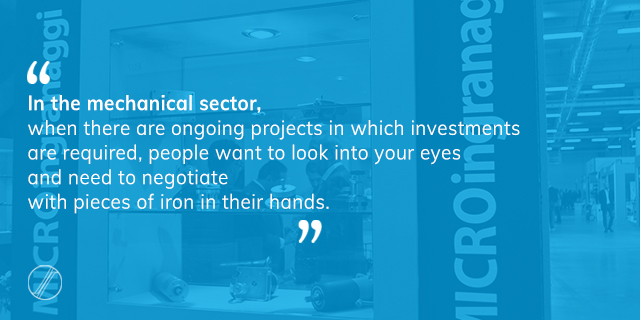I’ll start immediately with a question:
What do you think is behind the strong growth in the domestic market of tool machines of the first quarter of this year?
At the end of April the Studies Centre of UCIMU-Sistemi per produrre released data on the domestic market of machine tools, showing a +22.2% growth in the first quarter of 2017 compared with the same period of the previous year, and attributing much of the merit of this growth to government incentives
Hence hyper-amortisation at 250% and super-amortisation at 140%, to which Sabatini Ter was recently added (which can also be accumulated with super/hyper amortisation and incentives).
The same Massimo Carboniero, President of UCIMU, had stated: “The orders index for the first quarter of 2017 relating to the domestic market leaves no room for interpretations: the program devised by the government authorities is bearing fruit. The willingness of the Italian manufacturing sector to invest in industrial technology and in connectivity systems needed a boost that the Industry 4.0 National Plan ensured”.
Many manufacturers and distributors of machine tools share this sentiment, who not only use the government incentives as commercial leverage but who fear that once these measures come to an end, there will be the real risk of a market crash.
Do you agree?
At the risk of appearing to go against the trend, I think differently. In fact I believe that the increase in sales of machine tools occurred because finally a recovery is concrete and Italian companies (and I speak of course for my sector) are encountering a lot of work.
I have talked to several tool machine manufacturers who sustain that almost none of their customers has invested in technology using government incentives. And why haven’t they done so? Because the requirements to access them are very limiting and they end up excluding many businesses.
For investments below 500 thousand euro, self-certification is sufficient, but trade associations and manufacturers and distributors of tool machines are in any case strongly advised to designate to professionals the related administration in such a way as to pass on the responsibility.
So tight requirements, yes, but also a lack of information. It is true that today the media are focussing on this quite a lot at all levels. It is also true that many associations, institutions and trade fair organisers arrange informative meetings and conferences on the subject. But it is also the case that, unfortunately, on the other hand, there isn’t the interest to seek out the information. Several observers involved in this matter have highlighted that there are many Italian companies who have not yet thoroughly understood what it means specifically to produce in Industry 4.0.
Therefore, as only the companies that already have a structure designed for Industry 4.0 can access the Government incentives and as there are still many Italian companies that haven’t yet understood what this actually means in practical terms, it goes without saying that these companies are not adequately structured and therefore cannot access the incentives.
My fear is that, as so often happens, it is always and in any case the larger and more structured companies that benefit from these measures, only using part of the incentives for the development of the company, while the remainder disappears.
There is finally another important matter which should not be underestimated. As tool machines are in demand (because, as I have written, in my opinion, there is a lot of work and so they are needed), manufacturers today have very long delivery times, which – on average and with all the relevant exceptions – start from six months and upwards. This too must be borne in mind. Anyone who decides to invest in technology does so because they need that particular tool for work.





